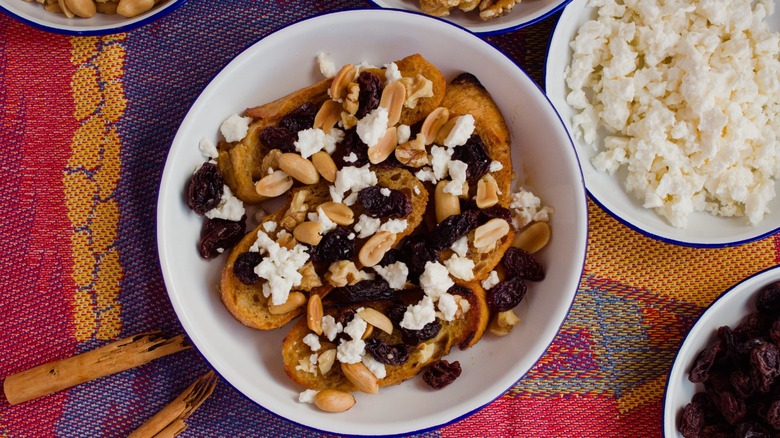The Symbolic Reason Mexican Capirotada Is Eaten During Lent
The origins of capirotada, a Mexican bread pudding, can be traced back to Spain. The first time this dish appeared in print under this name was in 1611 in a cookbook by Francisco Martínez Motiño, the chef to King Philip II of Spain. His version, however, wouldn't have worked for Lent since it included pork along with bread and cheese. The name of the dish still had religious connotations, however. It came from the word "capriote," which was the name of a monk's cone-shaped hat.
In time, capirotada evolved into the holiday dish that has become synonymous with Lent. It features slices of bread, ranging from bolillo, a crusty white bread, to pan de heuvo, which is softer and more tender. A syrup made from cones of raw cane sugar known as piloncillo also plays a crucial role in the dish. Raisins are another traditional element used in capirotada. Nuts and cheese are also vital to this dish. In fact, it is the ingredients themselves that have helped to form a symbolic link between capirotada and Lent.
Ingredients serve as religious symbols
Beginning on Ash Wednesday, Lent calls for the faithful to abstain from eating meat on Fridays until Easter (when lamb is usually served for a symbolic reason). Capirotada became a popular dish for this time because it was meatless and filling. The mixture of bread, cheese, spices, nuts, and fruit made for a hearty and yet symbolic meal. Many of these ingredients are seen as representing different religious elements of the final hours of Jesus Christ.
The slices of bread represent the body of Christ. The sugar syrup used in the dish is seen as Christ's blood, and the cheese, often queso fresco or cotija, sprinkled across the top reflects the Holy Shroud. Others consider the cinnamon sticks as the wooden beams used to make the cross on which Christ was crucified. Cloves can also be viewed as the nails that were hammered through Christ's body.
Beyond these key ingredients, the other elements of the dish may vary by region or by a family recipe. The nuts used are usually almonds or peanuts, but sometimes people add other types as well. Raisins are traditional in capirotada, and other fruits are often included as well, ranging from bananas to grapes to guavas. Some versions of capirotada use water-based syrup, while others incorporate milk to make a custardy base.

